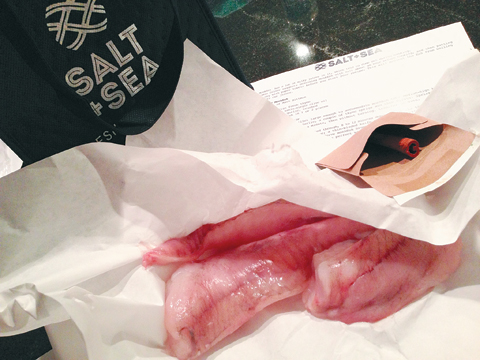
GET YOUR SHARE Fresh monkfish tails from the Salt and Sea Fishery-Supported Community, with a packet of spices to simmer to prevent fish odors from lingering in the kitchen. |
Fresh Maine sea scallops (dredged by day-boats or caught by divers) are everywhere this fleeting season, rebounding after a collapse that prompted a three-year-moratorium. The Maine shrimp season, at risk due to overfishing, opens a month late (on January 22 for trawlers), with catch limits reduced to only a quarter of last year's already curtailed quotas. And that most valuable and plentiful lobster fishery, after a five-year effort, is close to gaining "sustainable" status on the coveted Marine Stewardship Council list, though looming threats foretell a decline in future landings.
Gather those mild, non-fishy scallops while ye' may, as the harvest ends in March. Fishermen swear those sweet adductor muscles are best fresh from the shell, raw. I favor them cured as ceviche or atop nigiri sushi. Just be sure to demand that the scallops are local and not previously frozen. At home, rinse and wipe scallops, season and sear them for a couple minutes a side in a hot skillet with a little oil or butter, perhaps spooning on a tangy glaze. With their browned, crisp exterior (don't move them in the pan!) scallops should stay medium-rare in the center. Don't overcook them. Some briefly soak scallops in milk (or even coconut milk) before cooking, but with ones this fresh, it isn't necessary. I plan to follow Julia Child's advice to let scallops star in a bouillabaisse or a velouté (cream soup).
To boost the stocks of endangered fish, instead consume Maine's underutilized ones, perhaps by joining a community-supported fishery, or CSF. It's the same concept as community-supported agriculture, where members pay farmers a lump sum in advance for weekly baskets of vegetables. Port Clyde Fresh Catch launched the country's first CSF, a shot in the arm for Maine's last ground-fish fleet between Portland and Canada. They're also a major source of Maine shrimp. This year, Port Clyde is focusing "fish drops," where customers place orders online, pay by PayPal, then come pick up their fish at drop-off sites in Blue Hill and Thomaston. Portland's EatLocalFish.com operates under a similar model, delivering or shipping fish ordered online to the customer's door.
Then there's a new player, a new venture for a prominent fourth-generation fishing family, the Odlins. Salt and Sea Fishery-Supported Community delivers one- or two-pound packages of fresh monkfish, Atlantic pollock (better than Alaskan pollock, of surimi and Filet-O-Fish fame), Acadian redfish, gray sole (a kind of flounder), and haddock to weekly drop-offs around town at Rosemont Market, Woodfords Congregational Church, Scratch Baking Co. in South Portland, at the Peaks Island ferry terminal, and to Local Sprouts Café. It's worth joining the ranks of their 50-some members.
Founder Justine Simon worked in food policy and ran a CSA in Brooklyn before marrying Marty Odlin, an engineer on his family's boats. Simon wanted to recreate for members the food-sharing culture fishermen enjoy. When a boat comes in, the fish gets filleted and shared with all the extended family members. Salt and Sea includes extra treats, like crisp Gulf of Maine dulse and nori seaweed, and hake fish cakes.